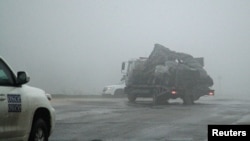After an American paramedic in the OSCE Special Monitoring Mission (SMM) in eastern Ukraine was killed and two other SMM members were injured when their vehicle ran over a land mine on April 23, the Russian Foreign Ministry immediately claimed the incident was a "provocation," implying that the Ukrainian army or forces loyal to Kyiv had deliberately attacked the vehicle as a way of undermining the Minsk peace negotiations.
TV Zvezda, the Russian military's TV station, went even further claiming the blast was supposedly the deliberate work of a "Ukrainian saboteur" linked to Ukraine's 8th special forces regiments, which had also been blamed by the Russian government for the murder of the chief of the Luhansk separatist’s militia Oleh Anashchenko, although there was no evidence for this claim.
Interestingly, the Russian government made the kind of speculative statements that Foreign Minister Sergei Lavrov misleadingly claimed Ukraine had made in March about the assassination of Russian MP Denis Voronenkov, saying "I thought democracy was about establishing facts when you have suspicions."
Despite the Foreign Ministry's initial invocation of a conspiracy, Lavrov later called for the probe into the incident to be "depoliticized" and called for a thorough investigation – although only Russia’s statements had been of a political nature.
The American was identified by the OSCE as Joseph Stone. The State Department issued a statement noting the dangerous conditions under which the monitors work, the threats they experience, and called for a "full, transparent, and timely investigation."
George Tuka, Ukraine’s deputy governor for the temporarily-occupied territories and displaced persons said the explosive device near the road in Pryshyb was apparently an anti-tank mine, i.e. not a bomb set off by a remote detonation as in the assassinations of a number of separatist commanders. He said the OSCE had frequently had its observer drones shot down by separatists and firearms had been used in "provocations" against the team as they traveled in the war zone.
The Russia-backed so-called "people's militia" of the Luhansk Region claimed that the OSCE car had traveled along a highway from Slavyanoserbsk to Sokolniki but had "diverted from the main road" and then taken "secondary roads", alleging this to be a violation of the OSCE's mandate.
But in a statement on April 23, the OSCE SMM said its two-vehicle convoy was traveling along a secondary road that it had used in the past near Pryshyb, 34 kilometers to the northwest of Luhansk, thereby indicating there was no “violation”. The second vehicle struck the mine.
While the investigation has yet to be completed, the most likely explanation for the tragic incident is that the OSCE vehicle randomly struck a land mine of which there are plenty in this area near the front line. Soldiers in the Donbas are frequently wounded or killed by stepping on mines as are civilians traveling in cars.
In April 2016, the UN estimated more than 600 Ukrainian soldiers and civilians had been killed by landmines and unexploded ordnance and 2,000 people had been wounded in the first two years of the war. On April 20, the Ukrainian Defense Ministry and Halo Trust, a UK NGO devoted to clearing mines, held a press conference in which they announced that 42 children had been killed and 109 children wounded by either mines or improper handling of munitions since the onset of hostilities in 2014.
Indeed, English Lugansk, a daily independent blogger of the war from the Luhansk region commented in response to the Russian Foreign Ministry's initial speculation that the incident was indicative of how many mines Russia had planted in the region.
It also must be noted that the OSCE SMM has come under attack multiple times in the last three years while performing its mission, usually from the separatist side.
The mission has been fired on a number of times when travelling in separatist-controlled territory and has been forced to withdraw. On February 3, mission members encountered three armed separatist fighters, one of whom fired at their vehicle. Just weeks later on February 25, the OSCE team was shot at near Yekaterinovka and on March 24 another such encounter was recorded with shots fired at the OSCE team near Znamianka.
Therefore, the blast of the OSCE vehicle was most likely an accident of war, but one for which the Russia-backed separatists who control the territory are ultimately responsible, in a context of steady escalation of threats and armed attacks.





